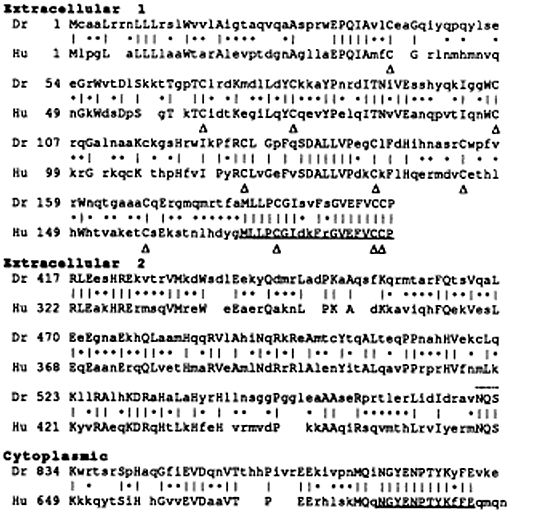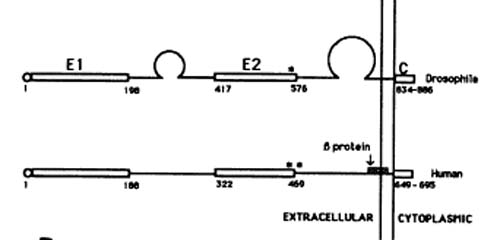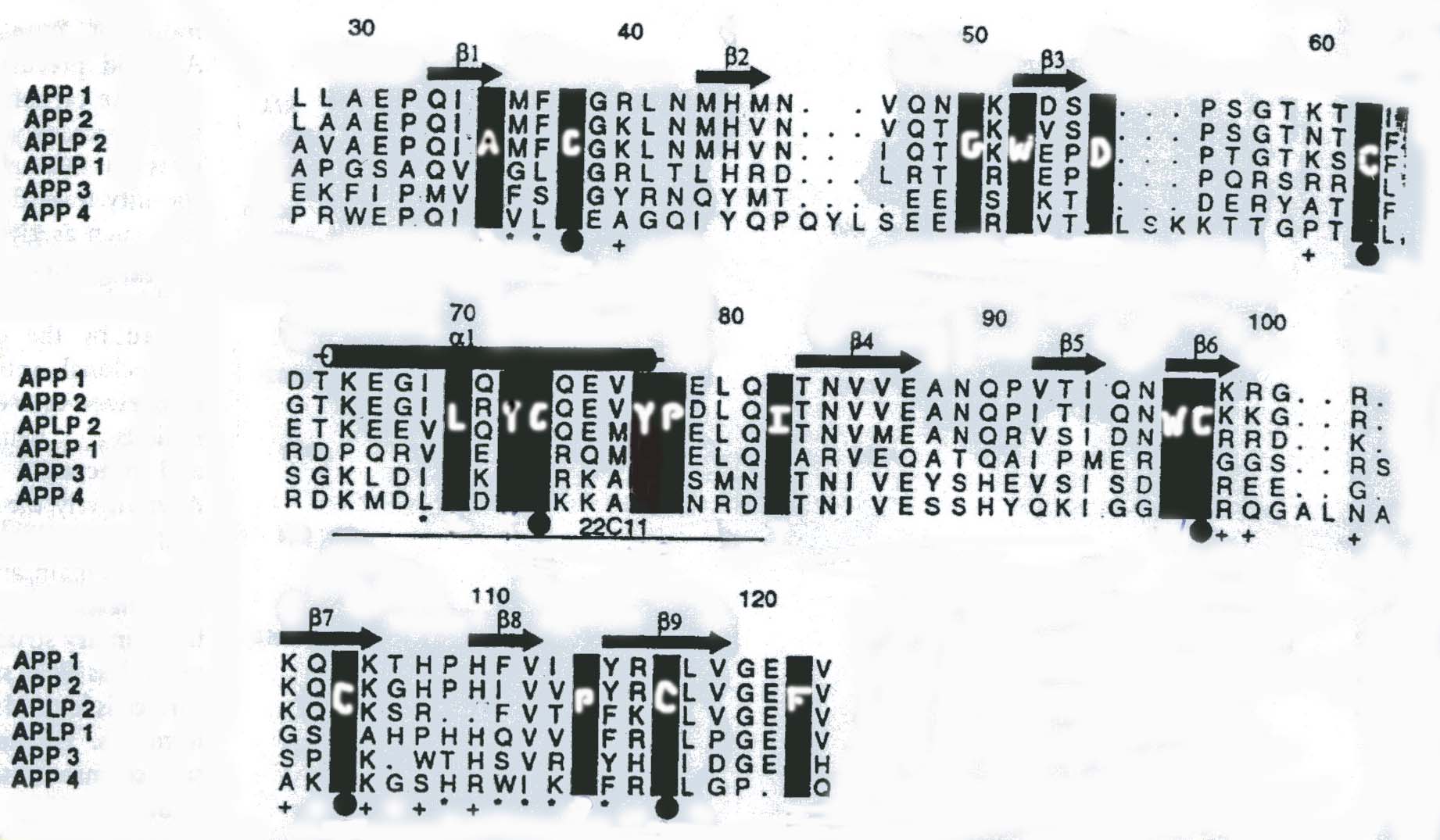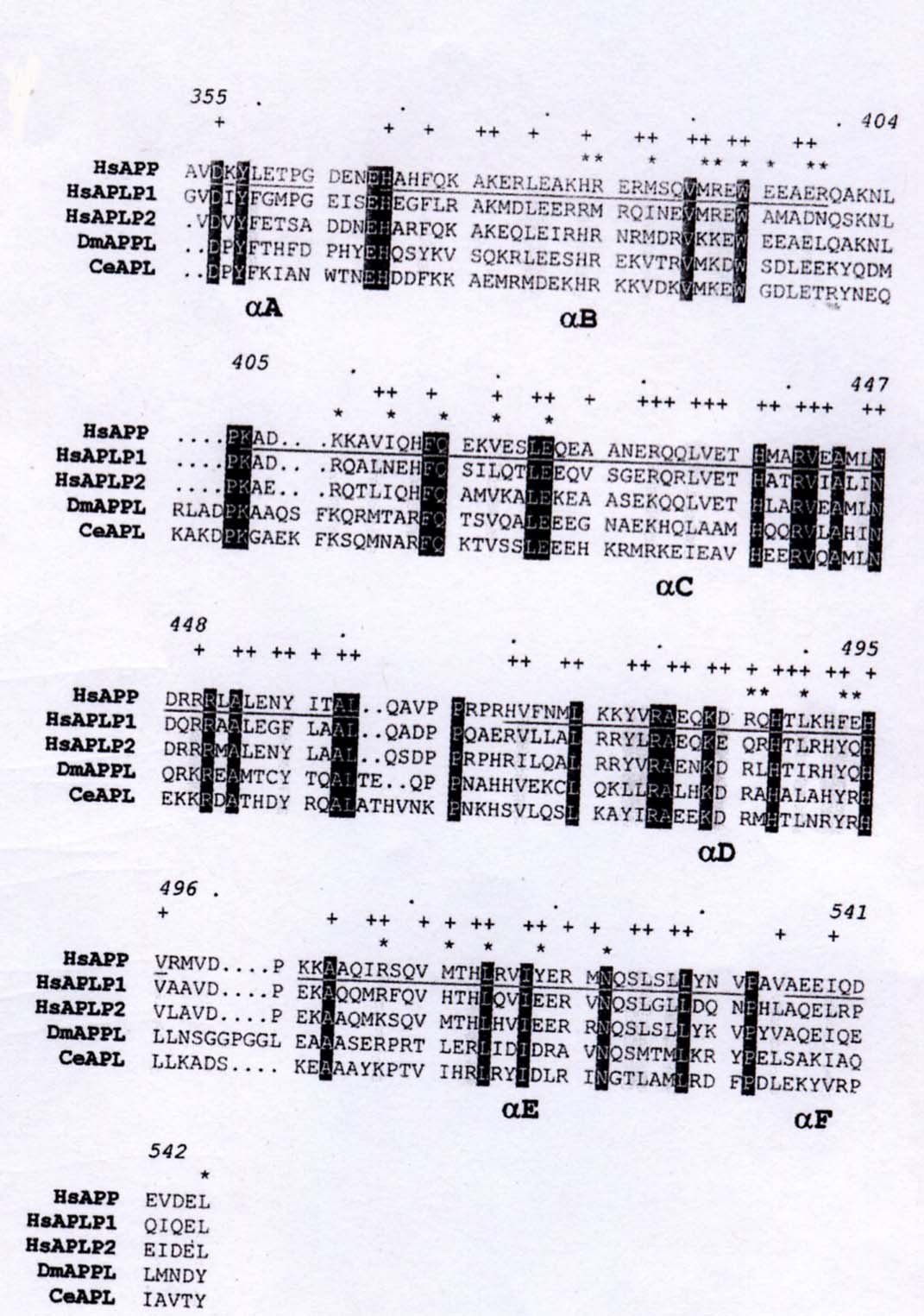Ortholog 6: Macaca fascicularis (Crab-eating Macaque)
APP Amino Acid Sequence (courtesy of Entrez):
mlpglallll aawtaralev ptdgnaglla epqiamfcgr lnmhmnvqng kwdsdpsgtk 60
tcidtkegil qycqevypel qitnvveanq pvtiqnwckr grkqckthph fvipyrclvg 120
efvsdallvp dkckflhqer mdvcethlhw htvaketcse kstnlhdygm llpcgidkfr 180
gvefvccpla eesdnvdsad aeeddsdvww ggadtdyadg sedkvvevae eeevaeveee 240
eadddedded gdeveeeaee pyeeatertt siattttttt esveevvrev cseqaetgpc 300
ramisrwyfd vtegkcapff yggcggnrnn fdteeycmav cgsvipttaa stpdavdkyl 360
etpgdeneha hfqkakerle akhrermsqv mreweeaerq aknlpkadkk aviqhfqekv 420
esleqeaane rqqlvethma rveatlndrr rlalenyita lqavpprprh vfnmlkkyvr 480
aeqkdrqhtl khfehvrmvd pkkaaqirsq vmthlrviye rmnqslslly nvpavaeeiq 540
devdellqke qnysddvlan miseprisyg ndalmpslte tkttvellpv ngefslddlq 600
pwhsfgadsv pantenevep vdarpaadrg lttrpgsglt nikteeisev kmdaefrhds 660
gyevhhqklv ffaedvgsnk gaiiglmvgg vviatv 696Compare this amino acid sequence to the Homo sapiens 695-APP sequence above. How are they different?
Ortholog 7: Danio rerio (Zebra fish)
APP Isoform-A Amino Acid Sequence (courtesy of Entrez) :
mrsrelfill mavastlave vpsdsgtgll aepqiamfcg klnmhiniqs gkwepdpsgs 60
kscignkegi lqycqevype lqitnvvean qpvsiwdwck ksrkqcrshm hivvpyrclv 120
gefvsdallv pdkckflhqe rmdmceshlh whtvakescg drsmnlhdyg mllpcgidrf 180
rgvefvccpa dagkesesaa veeddsdvww ggaeadyten smtrdaaaep avleddedad 240
eeededqdgd gdrdekieee eeeeertqst saaltstttt ttesveevvr evcfasaetg 300
pcramlsrwy yvreerrcap fiyggcggnr nnfeseeycl svcsgvlptp sssppdavdr 360
yletpadene hahflqakes letkhrerms qvmreweeae rqakslprnd kkaviqhfqe 420
kvealeqesa serqqlveth marveallnd rrrlalesyl salqadpprp rhvfsllkky 480
vraeqkdrqh tlkhfehvrm vdpkkaaqir pqvlthlrvi eermnqslgl lykvpgvadd 540
iqdqvellqr eqqemsaqla nlqsdarvsy gndalmpdst aglellpaed tqgfgfihpe 600
sfnqpnthnq vepvdarpvp dldlatrpvs glkpddipel rmeaeerhse vyhqklvffa 660
edvssnkgai iglmvggvvi atiivitlvm lrkkqytsih hgiievdaav tpeerhlskm 720
qqngyenpty kffeqmhn 738APP Isoform-B Amino Acid Sequence (courtesy of Entrez) :
mgidrtvfll lmlttlslai evpsddsvgl laepqvamfc gklnmhinvq sgkwepdptg 60
tkscistkeg ilkycqevyp dlqitnvvea nqpvsiqnwc kmgrrqcrsh thivvpyrcl 120
vgefvsdall vpdkckflhq ermdmceshl hwhtvakesc gdrsmnlhdy gmllpcgidr 180
frgvefvccp meeqkdldse eqeeansdvw wggaeteytd asvlkeqvta kpdpavtedd 240
edlnneeeev wdndedgdge ddedeeddde diideqdtse qtsniamttt tttttesiee 300
vvrvptmaps padavdryle apgdmnehmr fqkakeslea khrekmsevm reweeaerqa 361
knlpradkkt iiqrfqekve slekeaager qqlvethmar veallndrrr qalesylssl 420
qsdqprprqv lnllkkyira eqkdrqhtlk hfehvrevdp kkasqirpfv mthlrvieer 480
mnqslgylyk vpqvandiqd qvavlvqrdq aevtqqlssl qskmrvsygn dalmpdlpds 540
ttpldnlppe qdglgfihpe sfnqantdnh vepvdarpip erglptrpei pkvrldieer 600
hnagydvrdk rlmflaedmg snkgaiiglm vggvviatvi vitlvmlrkk qytsihhgvi 660
evdaavtpee rhlakmqqng yenptykffe qmqn 694It is important to note that the APP sequences for this fish species are correspond less frequently to Homo sapiens APP isoforms than the other vertebrate orthologs. This suggests that the gene experienced more changes as evolution occured from fish to birds and mammals.
Ortholog 8: Drosophila melanogaster (Fruit Fly)
Fruit flys produce Amyloid Precursor-like Proteins coded by their genome.
APP-like Amino Acid Sequence (courtesy of Ensembl):
MCAALRRNLL LRSLWVVLAI GTAQVQAASP RWEPQIAVLC EAGQIYQPQY LSEEGRWVTD 60
LSKKTTGPTC LRDKMDLLDY CKKAYPNRDI TNIVESSHYQ KIGGWCRQGA LNAAKCKGSH 120
RWIKPFRCLG PFQSDALLVP EGCLFDHIHN ASRCWPFVRW NQTGAAACQE RGMQMRSFAM 180
LLPCGISVFS GVEFVCCPKH FKTDEIHVKK TDLPVMPAAQ INSANDELVM NDEDDSNDSN 240
YSKDANEDDL DDEDDLMGDD EEDDMVADEA ATAGGSPNTG SSGDSNSGSL DDINAEYDSG 300
EEGDNYEEDG AGSESEAEVE ASWDQSGGAK VVSLKSDSSS PSSAPVAPAP EKAPVKSESV 360
TSTPQLSASA AAFVAANSGN SGTGAGAPPS TAQPTSDPYF THFDPHYEHQ SYKVSQKRLE 420
ESHREKVTRV MKDWSDLEEK YQDMRLADPK AAQSFKQRMT ARFQTSVQAL EEEGNAEKHQ 480
LAAMHQQRVL AHINQRKREA MTCYTQALTE QPPNAHHVEK CLQKLLRALH KDRAHALAHY 540
RHLLNSGGPG GLEAAASERP RTLERLIDID RAVNQSMTML KRYPELSAKI AQLMNDYILA 600
LRSKDDIPGS SLGMSEEAEA GILDKYRVEI ERKVAEKERL RLAEKQRKEQ RAAEREKLRE 660
EKLRLEAKKV DDMLKSQVAE QQSQPTQSST QSQAQQQQQE KSLPGKELGP DAALVTAANP 720
NLETTKSEKD LSDTEYGEAT VSSTKVQTVL PTVDDDAVQR AVEDVAAAVA HQEAEPQVQH 780
FMTHDLGHRE SSFSLRREFA QHAHAAKEGR NVYFTLSFAG IALMAAVFVG VAVAKWRTSR 840
SPHAQGFIEV DQNVTTHHPI VREEKIVPNM QINGYENPTY KYFEVKE 887
Comparison between Homo sapiens 695-APP and Drosophila melangaster 886-APP (Rosen DR, et al., 1988):
The amino acid sequences of APP in these two species markedly similar, even though Homo sapiens is classified as vertebrate and Drosophila melangaster is classified as invertebrate (their common ancestor appears further back in history). The amino acid comparision is illustrated in Figure 1 below.
Figure 1: APP Amino acid alignment between two different species, Homo sapiens (Hu) and Drosophila melangaster (Dr). The alignments appear in groups of three lines and are divided by regions of the protein (extracellular 1, extracellular 2, and cytoplasmic). Drosophila APP primary structure appears on the top line, followed by a comparison table in between, and the Homo sapiens APP primary structure on the bottom. Numbers represent order of amino acids. The vertical lines in the comparison line and the capital letters in the amino acid sequences represent identical matches in the two species. Dots in the comparison line represent similar corresponding amino acids (partial match). Triangles represent conserved cytosine amino acids in both species. An especially long stretch of homolgy is underlined. Image courtesy of (Rosen DR, et al., 1989), permission granted by Dr. Kalpana White: 3/9/05.
An alternative representation of the comparison between these two proteins is depicted below in Figure 2.
Figure 2. Cartoon of Drosophila and Human APP homology. The numbers represent order of amino acids. The E1, E2, and C represent extracellular region 1, extracellular region 2, and cytoplasmic region, respectively. The loops in the Drosophila model represent additional amino acids in the sequence. The black box and the arrow in the human model indicate the location of the ß-Amyloid domain present only in the human amino acid sequence. The dots represent glycosylation sites. Image courtesy of (Rosen DR, et al., 1989), permission granted by Dr. Kalpana White: 3/9/05.
Indeed, the amnio acid sequences and overall structure of human and fruit fly APP contain several conserved regions even though they are more distantly related. In particular, see the N-terminal domain and E2 domain sections below for implications of particular regions of homology. Important differences appear as there is an additional glycosylation site in human APP and a ß-Amyloid domain of human APP. The amino acid sequence of Drosophila APP is also much longer than human APP.
Ortholog 9: Caenorhabditis elegans (Nematode)
APP-like Isoform-A1 Amino Acid Sequence (courtesy of Ensembl):
MTVGKLMIGL LIPILVATVY AEGSPAGSKR HEKFIPMVAF SCGYRNQYMT EEGSWKTDDE 60
RYATCFSGKL DILKYCRKAY PSMNITNIVE YSHEVSISDW CREEGSPCKW THSVRPYHCI 120
DGEFHSEALQ VPHDCQFSHV NSRDQCNDYQ HWKDEAGKQC KTKKSKGNKD MIVRSFAVLE 180
PCALDMFTGV EFVCCPNDQT NKTDVQKTKE DEDDDDDEDD AYEDDYSEES DEKDEEEPSS 240
QDPYFKIANW TNEHDDFKKA EMRMDEKHRK KVDKVMKEWG DLETRYNEQK AKDPKGAEKF 300
KSQMNARFQK TVSSLEEEHK RMRKEIEAVH EERVQAMLNE KKRDATHDYR QALATHVNKP 360
NKHSVLQSLK AYIRAEEKDR MHTLNRYRHL LKADSKEAAA YKPTVIHRLR YIDLRINGTL 420
AMLRDFPDLE KYVRPIAVTY WKDYRDEVSP DISVEDSELT PIIHDDEFSK NAKLDVKAPT 480
TTAKPVKETD NAKVLPTEAS DSEEEADEYY EDEDDEQVKK TPDMKKKVKV VDIKPKEIKV 540
TIEEEKKAPK LVETSVQTDD EDDDEDSSSS TSSESDEDED KNIKELRVDI EPIIDEPASF 600
YRHDKLIQSP EVERSASSVF QPYVLASAMF ITAICIIAFA ITNARRRRAM RGFIEVDVYT 660
PEERHVAGMQ VNGYENPTYS FFDSKA 686
APP-like Isoform-B1 Amino Acid Sequence (courtesty of Ensembl):
MTVGKLMIGL LIPILVATVY AEGSPAGSKR HEKFIPMVAF SCGYRNQYMT EEGSWKTDDE 60
RYATCFSGKL DILKYCRKAY PSMNITNIVE YSHEVSISDW CREEGSPCKW THSVRPYHCI 120
DGEFHSEALQ VPHDCQFSHV NSRDQCNDYQ HWKDEAGKQC KTKKSKGNKD MIVRSFAVLE 180
PCALDMFTGV EFVCCPNDQT NKTDVQKTKE DEDDDDDEDD AYEDDYSEES DEKDEEEPSS 240
QDPYFKIANW TNEHDDFKKA EMRMDEKHRK KVDKVMKEWG DLETRYNEQK AKDPKGAEKF 300
KSQMNARFQK TVSSLEEEHK RMRKEIEAVH EERVQAMLNE KKRDATHDYR QALATHVNKP 360
NKHSVLQSLK AYIRAEEKDR MHTLNRYRHL LKADSKEAAA YKPTVIHRLR YIDLRINGTL 420
AMLRDFPDLE KYVRPIAVTY WKDYRDEVSP DISVEDSELT PIIHDDEFSK NAKLDVKAPT 480
TTAKPVKETD NAKVLPTEAS DSEEEADEYY EDEDDEQVKK TPDMKKKVKV VDIKPKEVTI 540
EEEKKAPKLV ETSVQTDDED DDEDSSSSTS SESDEDEDKN IKELRVDIEP IIDEPASFYR 600
HDKLIQSPEV ERSASSVFQP YVLASAMFIT AICIIAFAIT NARRRRAMRG FIEVDVYTPE 660
ERHVAGMQVN GYENPTYSFF DSKA 684Compare the amino acid sequences of the C. elegans and Homo sapiens APP. Like the fruit fly, the amnio acid sequences of human and C. elegans APP contain several conserved regions even though they are more distantly related. In particular, see the N-terminal domain and E2 domain sections below for implications of particular regions of homology. How are the two sequences different?
The alignment of specific domains of APP of various species can be compared to determine amino acids that are especially important for protein function or amino acids critical in dysfunction in humans.
N-Terminal Domain
Scientists have found that the N-terminal domain of human, electric ray, C. elegans, and Drosophila APPs are between 36% and 84% conserved across species. In particular, all of the cytoseine residues and the hydrophobic core are fully conserved among species. These regions of this domain play critical roles in the folding of the protein and their conservation suggests that the overall shape of the APP N-terminal domain was maintained throughout evolution (Rossjohn J, et. al., 1999). See Figure 3 below for a visual representaion of the alignment.
Figure 3. Alignment of amino acid sequences for N-Terminal, growth factor like domain of APPs from various species. APP 1 represents Homo sapiens APP, APP 2 represents electric ray APP, APP 3 represents C. elegans APP, APP 4 represents Drosophila APP. APLP 1, 2 represent human APP-like proteins. The numbers above the column letters represent order of amino acids. The numbered ßs, alphas, and arrows above the amino acid code indicate the location of secondary structure of the protein. The small dots below the amino acid code represent hydrophobic amino acids, while the +s indicate conserved positively charged amino acids. The large dot below the amino acids represent conserved cytosine residues. The shaded boxes represent amino acids conserved throughout all species/proteins. Image courtesy of (Rossjohn J, et al., 1999), permission granted by Dr. Michael Parker: 2/24/05.
E2 Domain
Scientists have found that amino acids critical to the folding and dimerization of the E2 domain of APP are highly conserved across species. The overall conservation of the domain is 33%, while the conservation of the amino acids involved in the helical packing is 64%. Thus, the folding and dimerization ability of this domain likely critical to APP function (Wa Y, Ha Y, 2004). See Figure 4 below for a visual representation of the alignment.
Figure 4. Alignment of amino acid sequences of E2 domain of APPs from various species. HsAPP represents Homo sapiens APP, while HsAPLP1 and 2 represent Homo sapiens AP-like proteins. DmAPPL and CeAPL represent Drosophila and C. elegans APP. The numbers above the single letter amino acid code represent number of amino acids. The asterisks represents amino acids connecting dimer interfaces, while the +s indicate amino acids involved in helical coiling of the domain. The alpha A-F indicate the positions of the six alpha helices of the secondary structure. The shaded boxes represent amino acid conserved across all species. Image courtesy of (Wang Y, Ha Y, 2004), permission granted by Dr. Ya Ha: 2/16/05.
ß-Amyloid Domain
Scientists have found that the 42 amino acid ß-Amyloid domains of Human, Dog, Pig, Polar Bear, Rabbit, Sheep, Cow, and Guinea Pig APPs are identical. Their corresponding nucleotide sequences only have silent differences. All of these species exhibit the ß-Amyloid neuronal plaques characteristic of Alzheimer's Disease in old age. However, the corresponding amino acid sequences of ß-Amyloid domains of rat and mouse species contain three amino acid changes. The alignment of the divergent amino acid sequences appears below adapted from an in image in (Johnstone EM, et al., 1991). The differing amino acids appear in bold.
DAEFRHDSGYEVHHQKLVFFAEDVGSNKGAIIGLMVGGVVIA Human,Dog, Pig etc. ß-Amyloid Domain
DAEFGHDSGFEVRHQKLVFFAEDVGSNKGAIIGLMVGGVVIA Rat,Mouse ß-Amyloid Domain
It is interesting to note that normal mice and rats only rarely exhibit ß-Amyloid neuronal plaques characteristic of Alzheimer's disease. These findings indicate the these three differing amino acids may play an important role in the development or lack of development of degenerative neuronal plaques (Johnstone EM, et al., 1991).
For more information about APP orthologs and their significance: Visit the APP Genecard or the Ensembl Gene Report.
References:
Johnstone EM, et al. 1991. Conservation of the Alzheimer's disease amyloid peptide in dog, polar bear and five other mammals by cross-species polymerase chain reaction analysis. Molecular Brain Research 10: 299-305.
Rosen DR, et al. 1989 Apr. A Drosophila gene encoding a protein resembling the human ß-amyloid protein precursor. Proc Natl Acad Sci USA 86: 2478-2482.
Rossjohn J, et al. 1999 Apr. Crystal structure of the N-terminal, growth factor-like domain of Alzheimer amyloid precursor protein. Nature Structural Biology 6 (4): 327-331.
Wang Y, Ha Y. 2004 Aug 13. The X-Ray Structure of an Antiparallel Dimer of the Human Amyloid Precursor Protein E2 Domain. Molecular Cell 15: 343-353



